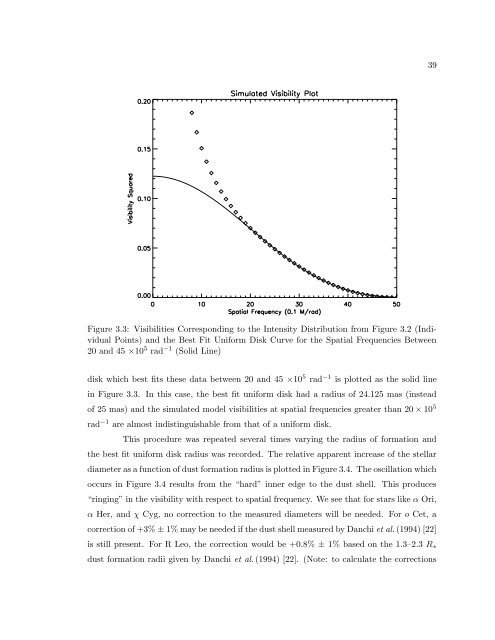The Size, Structure, and Variability of Late-Type Stars Measured ...
The Size, Structure, and Variability of Late-Type Stars Measured ...
The Size, Structure, and Variability of Late-Type Stars Measured ...
You also want an ePaper? Increase the reach of your titles
YUMPU automatically turns print PDFs into web optimized ePapers that Google loves.
39<br />
Figure 3.3: Visibilities Corresponding to the Intensity Distribution from Figure 3.2 (Individual<br />
Points) <strong>and</strong> the Best Fit Uniform Disk Curve for the Spatial Frequencies Between<br />
20 <strong>and</strong> 45 ×10 5 rad −1 (Solid Line)<br />
disk which best fits these data between 20 <strong>and</strong> 45 ×10 5 rad −1 is plotted as the solid line<br />
in Figure 3.3. In this case, the best fit uniform disk had a radius <strong>of</strong> 24.125 mas (instead<br />
<strong>of</strong> 25 mas) <strong>and</strong> the simulated model visibilities at spatial frequencies greater than 20 × 10 5<br />
rad −1 are almost indistinguishable from that <strong>of</strong> a uniform disk.<br />
This procedure was repeated several times varying the radius <strong>of</strong> formation <strong>and</strong><br />
the best fit uniform disk radius was recorded. <strong>The</strong> relative apparent increase <strong>of</strong> the stellar<br />
diameter as a function <strong>of</strong> dust formation radius is plotted in Figure 3.4. <strong>The</strong> oscillation which<br />
occurs in Figure 3.4 results from the “hard” inner edge to the dust shell. This produces<br />
“ringing” in the visibility with respect to spatial frequency. We see that for stars like α Ori,<br />
α Her, <strong>and</strong> χ Cyg, no correction to the measured diameters will be needed. For o Cet, a<br />
correction <strong>of</strong> +3% ± 1% may be needed if the dust shell measured by Danchi et al. (1994) [22]<br />
is still present. For R Leo, the correction would be +0.8% ± 1% based on the 1.3–2.3 R ∗<br />
dust formation radii given by Danchi et al. (1994) [22]. (Note: to calculate the corrections













![Problem #1 [Structure Formation I: Radiation Era]](https://img.yumpu.com/37147371/1/190x245/problem-1-structure-formation-i-radiation-era.jpg?quality=85)


